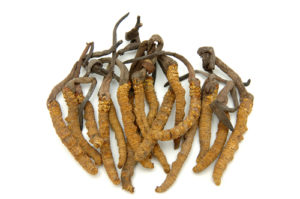Cordyceps is a Chinese fungus used in Traditional Chinese Medicine (TCM) for “lung protection” and “reproductive invigoration” as well as to balance the “Qi” – the fundamental “energy of life.” Cordyceps is also known as the Chinese caterpillar fungus because it is a parasitic organism that grows on a rare Tibetan caterpillar until the caterpillar dies and the mushroom sprouts from the caterpillar’s head.
Owing to the herb’s high efficacy and potency in curing various diseases, it is well known as an important nourishing tonic. However, as the source and the gathering of the herb is rare and difficult, so its supply often falls short of demand.
Cordyceps sinesnsis is the only species of this genus found in Nepal.
Family – Hypocreaceae
Local Name – Yarsagumba, Jivanbuti, Buti
Chinese Name – Dong Chong Xia Cao
English Name – Caterpillar Mushroom, Cordyseps
Yartshagumba has two components the lower part is dead caterpillar and the upper part is a fungus. The fungus has a small spike with dark brown fructification and yellowish white stalk. The size of the fungus is about 4 to 12 cm in length and 0.14 to 0.4 cm in girth. The meaning of Yarsagumba is ‘summer-grass winter-worm’ in Tibetan language. Yarsagumba with both the caterpillar and fungal part in an intact single piece is an item of commerce.
Yartshagumba is extremely rare. It is distributed in the alpine region of the Himalayas at the elevation of more than 4000m. It is mainly found above the snowline in Dolpa, Jumla, Humla, Kalikot, Baglung, Mustang, Manang, and Rasuwa districts of western and central Nepal. Major confinement of this species in Jumla district is within Patarasi, Chhumchaur, Dillichaur and Patmara VDCs of eastern sector Chaudavisa river valley.
The fungus grows on the caterpillar during monsoon (rainy season). As the spores of the fungus Terminate and grow on a living, caterpillar. The caterpillar eventually dies. It takes five to seven years for the fungus to complete its life cycle and produce the natural product.
Yartshagumba only grows under very specific and hard-to-duplicate conditions. The species grows only in the Himalayas. There the temperature is low year round. The high altitude limits the Oxygen available. These harsh conditions, which make life difficult even for most fungi, is perfect for growing Cordyceps.
The associated plant species of this species are Kutki (Picrorhiza scrophulariiflora), Jatamansi (Nardostachys grandiflora), Bukiphool (Anaphalis sp.) and other high altitude grasses.
Natural regeneration takes place from the spores of the fungus. At the beginning of the monsoon period, the spores attack the caterpillar just after it has emerged from its cocoon. If the fungus is collected in early monsoon then the caterpillar is still seen alive, later monsoon, at the time of collection, the caterpillar will not be alive. The fungal part of this species can be seen growing out of the ground immediately after the snow melts the caterpillar part remains buried under the soil. This species is not cultivated in Nepal. Although, Yartshagumba is being cultivated in America by growing the strain on soybeans for medicinal uses.
In the Karnali, Yartshagumba is harvested from June to August; the best time is late monsoon. To collect one has to look at grass level; the fungus has a small spike with dark brown fructification and yellowish white stalk. Collection is done by manual picking without using any tools regardless of age of Yartshagumba.
